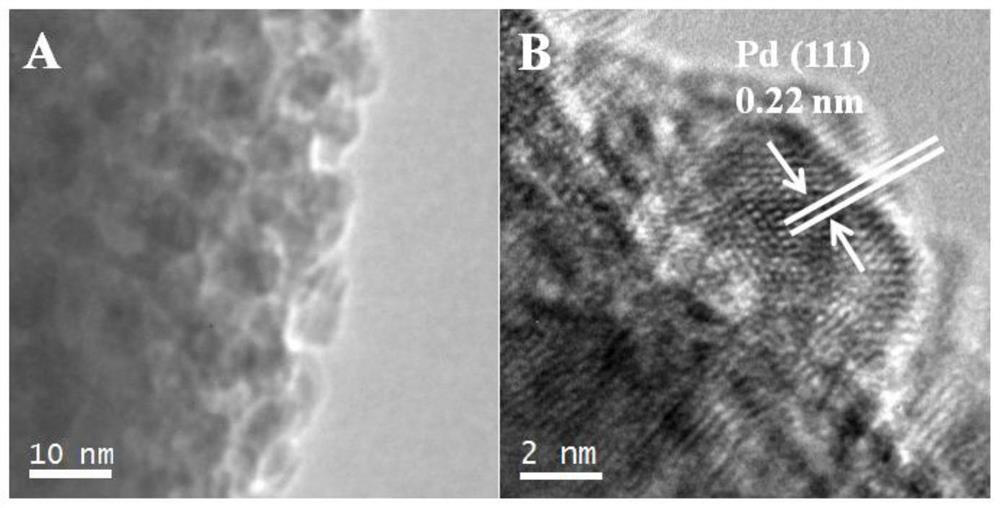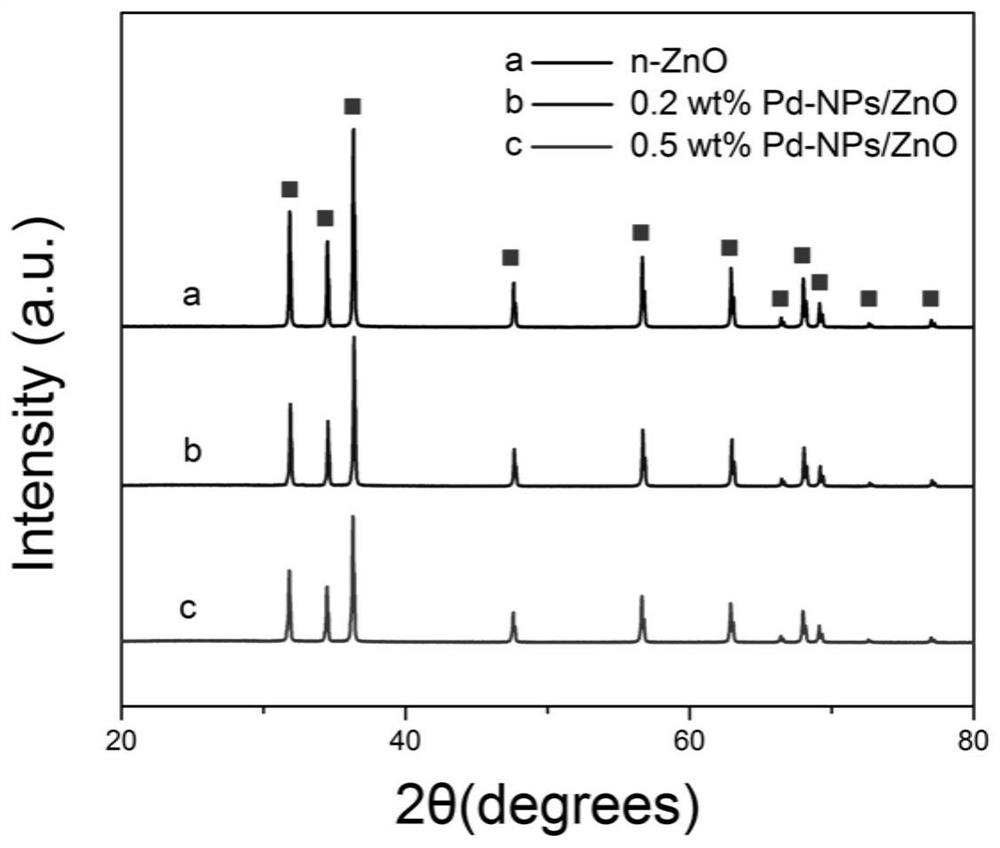Nano-enzyme with nano-zinc oxide loading palladium nanoparticles as well as preparation method and application of nano-enzyme
A nano-zinc oxide and palladium nano-technology, applied in chemical instruments and methods, botanical equipment and methods, catalyst activation/preparation, etc., can solve problems such as inability to achieve antibacterial purposes and hazards, and improve enzyme catalytic activity and reaction process Controllable, easy-to-prepare effects
- Summary
- Abstract
- Description
- Claims
- Application Information
AI Technical Summary
Problems solved by technology
Method used
Image
Examples
Embodiment 1
[0033] ZnO-supported palladium nanoparticles nanozyme (Pd-NPs / ZnO)
[0034] (1) preparation method comprises the steps:
[0035] 1. Put 200mg of zinc oxide (n-ZnO) nanomaterials in a round-bottomed flask containing 20mL of deionized water, and ultrasonically disperse them uniformly for about 30 minutes before use. According to the loading amount of palladium (Pd) is 0.2wt% and 0.5wt%, respectively dropwise add 0.109mL, 0.272mL palladium nitrate solution with a concentration of 8mg / mL in the solution, then add 0.3mLNa 2 CO 3 The solution was adjusted to pH=8-9. Then the mixture was heated at 90°C for 2h, cooled to room temperature, washed several times, filtered and dried in an oven at 60°C, and finally heated at 200°C under H 2 0.2wt%, 0.5wt% Pd-NPs / ZnO nanozyme can be obtained after reduction for 2h.
[0036] (2) Detection
[0037] figure 1 It is the relevant TEM image of 0.2wt% Pd-NPs / ZnO nanocomposite. Depend on figure 1 It can be seen that the palladium nanoparticl...
Embodiment 2
[0041] Mimetic peroxidase activity of nanozyme Pd-NPs / ZnO supported by palladium nanoparticles on ZnO (1) TMB experiment of n-ZnO, 0.2wt% Pd-NPs / ZnO and 0.5wt% Pd-NPs / ZnO
[0042] The simulated peroxidase activity of n-ZnO, 0.2wt% Pd-NPs / ZnO and 0.5wt% Pd-NPs / ZnO was determined by TMB experiment.
[0043] Method: Select 3,3',5,5'-tetramethylbenzidine (TMB) as the chromogenic substrate of peroxidase, take a certain amount of nanozyme and a certain concentration of H 2 o 2After the solution is mixed, it can effectively catalyze and oxidize TMB into blue oxidation state TMB (oxTMB), and there is a characteristic absorption peak at 652nm in the ultraviolet-visible absorption spectrum. By comparing the change of absorbance, it can be judged that n-ZnO, 0.2 Whether wt% Pd-NPs / ZnO and 0.5wt% Pd-NPs / ZnO nanozymes have mimic peroxidase activity.
[0044] Figure 4 It is the TMB experiment diagram of n-ZnO, 0.2wt% Pd-NPs / ZnO and 0.5wt% Pd-NPs / ZnO. Figure 4 where A and B are TMB con...
Embodiment 3
[0048] Antibacterial application of nanozyme Pd-NPs / ZnO loaded with palladium nanoparticles on ZnO
[0049] Antibacterial experiment, including the following steps:
[0050] 1) Preparation of LB medium: Weigh 8.25g of nutrient agar into an Erlenmeyer flask, add 250mL of deionized water and ultrasonically dissolve it, adjust pH=7.2-7.4 with sodium hydroxide, and obtain a solid medium. Sterilize under the conditions of 0.1MPa and 120°C, pour it into a flat plate, and place it on the upper shelf of the refrigerator for use. Weigh 0.5g of yeast extract powder, 1g of sodium chloride and 1g of tryptone into an Erlenmeyer flask, add 100mL of deionized water and ultrasonically dissolve it, and adjust the pH to 7.2-7.4 with sodium hydroxide to obtain liquid culture base, sterilized under the same conditions and placed on the upper shelf of the refrigerator for later use. All glass instruments used in the experiment were sterilized in an autoclave for use.
[0051] 2) After sterilizi...
PUM
| Property | Measurement | Unit |
|---|---|---|
| optical density | aaaaa | aaaaa |
Abstract
Description
Claims
Application Information
 Login to View More
Login to View More - Generate Ideas
- Intellectual Property
- Life Sciences
- Materials
- Tech Scout
- Unparalleled Data Quality
- Higher Quality Content
- 60% Fewer Hallucinations
Browse by: Latest US Patents, China's latest patents, Technical Efficacy Thesaurus, Application Domain, Technology Topic, Popular Technical Reports.
© 2025 PatSnap. All rights reserved.Legal|Privacy policy|Modern Slavery Act Transparency Statement|Sitemap|About US| Contact US: help@patsnap.com



